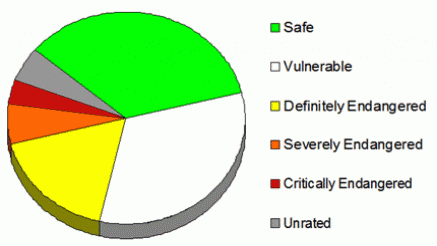World Statistics
According to a recent count, there are 7,106 living languages spoken by 6.3 billion people.
Mother-tongue speakers of the five largest languages alone—Chinese, Spanish, English, Hindi and Arabic—make up 39% of the world’s population. Together the ten largest languages—add Bengali, Portuguese, Russian, Japanese and Javanese—account for 51% of the world’s population.
In all, just 6% of the world’s languages (less than four hundred languages) account for 94% of the world’s population.
Conversely, 94% of the world’s languages are spoken by only 6% of the world’s population. Said another way, some 6700 languages are spoken by a total of only 360 million people. That means most of the world’s languages have relatively few speakers.
- 81% of the world’s languages have fewer than 100,000 speakers.
- 56% of the world’s languages have fewer than 10,000 speakers.
- 28% of the world’s languages have fewer than 1,000 speakers.
- 13% of the world’s languages have fewer than 100 speakers.
If we consider languages with less than 20,000 speakers to qualify as endangered, then two-thirds of the world’s languages are endangered.
If we consider languages with less than 100,000 speakers to qualify as endangered, then four-fifths of the world’s languages are endangered.
Over eighty percent of the world’s languages are restricted to single countries, and so are particularly exposed to the policies of a single government.
Sulawesi Statistics
The island of Sulawesi in Indonesia is the eleventh largest island in the world, just behind Great Britian in terms of land area.
Sulawesi and its immediate offshore islands are home to 114 indigenous languages. That’s more languages on this one island than are spoken in most countries.
Sulawesi is the third-most linguistically diverse island in the world. Only the islands of Borneo and New Guinea are home to more languages.
The median-size language across Sulawesi is 13,000 speakers.
Of Sulawesi’s 114 indigenous languages:
- only four languages have more than a million speakers: Bugis, Makasar, Manado Malay and Gorontalo;
- ninety languages have less than 100,000 speakers;
- fifty languages have less than 10,000 speakers;
- twenty-three languages have less than 2,000 speakers.
The vitality of a language can be reported using UNESCO’s Endangerment Status Ratings. Overall vitality is reported using a six-point scale (Safe, Vulnerable, Definitely Endangered, Severely Endangered, Critically Endangered, Extinct). As of this writing, six languages of Sulawesi are unrated due to lack of information. Of the remaining 107 languages:
- only forty languages can be considered ‘Safe’;
- thirty-seven languages are ‘Vulnerable’;
- twenty languages are ‘Definitely Endangered’;
- seven languages are ‘Severely Endangered’;
- four languages are ‘Critically Endangered.’

Return to:
About Endangered Languages
About Sulawesi
